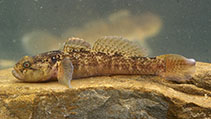| Family: |
Gobiidae (Gobies), subfamily: Gobiinae |
| Max. size: |
8.6 cm TL (male/unsexed); 7.5 cm TL (female) |
| Environment: |
demersal; freshwater; pH range: 7 - 7.5; dH range: 10 |
| Distribution: |
Europe: Italian rivers of the northern Adriatic, northwards from the Marches, and including the Po basin (with Swiss tributaries) and Venezia, as well as the Dalmatian rivers Zrmanje and Krka. |
| Diagnosis: |
Vertebrae: 28-29. No head lateral-line canals; paired rows of interorbital papillae, with short single transverse row often present at midpoint of interorbit. Typically D2 I/10 (9-11) (Ref. 12215). This species is distinguished from other gobies in freshwaters of Adriatic basin and Italy by the following characters: no cephalic lateral line canals; branched rays in second dorsal 11-12.5; scales in midlateral series 29-43; completely scaled caudal peduncle (Ref. 59043). |
| Biology: |
Found in streams with moderate flow over pebble beds, from altitudes of 400 m to sea level, and also at lake edges (with dense vegetation or coarse gravel, Ref. 59043). Spawns for the first time at 1 year; spawning season in April to July, when temperature reaches 20°C; females may repeat spawning during a season. Adhesive eggs deposited between stones, shells and aquatic plants and males guard the eggs until hatching. When spawning and defending the nest, males produce sounds. Feeds on a variety of benthic invertebrates (Ref.59043).
Territorial, usually burrows under flat stones. A short-lived species which is threatened by pollution and habitat destruction (Ref. 26100). Known to be invasive in Italy and has massively expanded its range south since the last decades (Ref. 92840). |
| IUCN Red List Status: |
Least Concern (LC); Date assessed: 05 March 2010 Ref. (130435)
|
| Threat to humans: |
harmless |
| Country info: |
|
Source and more info: www.fishbase.org. For personal, classroom, and other internal use only. Not for publication.

